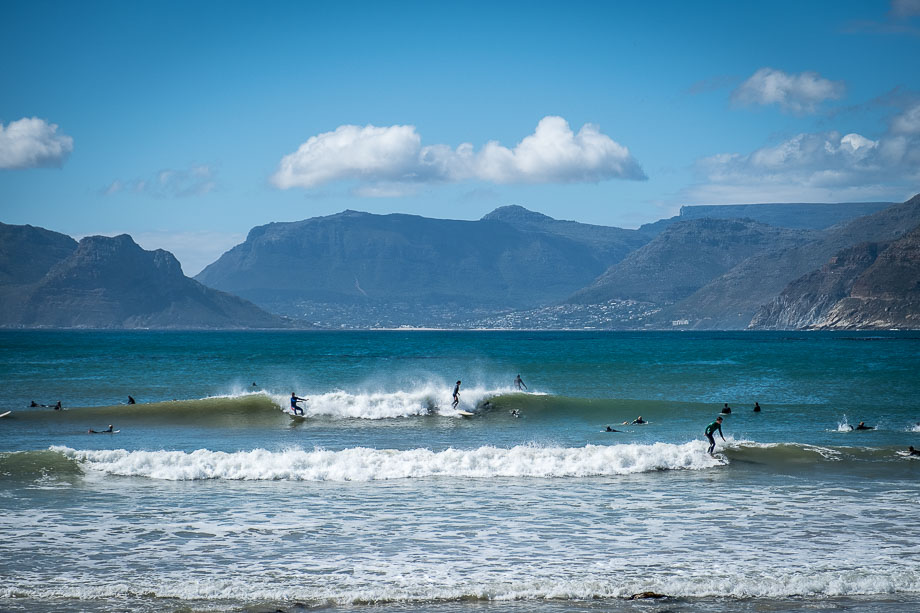The Cape Peninsula is the most south-western part of Africa. It’s an essential stop for any visit to Cape Town and South Africa. The scenery is spectacular and the biodiversity rich. You need your own transport or you can join a tour. I did the Luck and Lost tour.
Muizenburg
This is Cape Town’s premier surf destination. The water is slightly warmer here than on the western beaches, but you still need a wetsuit. Muizenburg has a bit of a run-down feel to it and was apparently pretty rough up until a few years ago when developers moved in. It’s not safe to walk around at night and don’t go hiking in the surrounding hills unless you want to get stabbed. Muizenburg hosts the cool Bluebird Market on Friday evenings. You can easily reach Muizenburg from Cape Town by train, but expect noisy crowds, bag-snatching and stinky Rastas.
Kalk Bay
Kalk Bay is a cool artists’ village located a little further along the same train line as Muizenburg. There is a really cool vibe here with plenty of galleries and cool restaurants, the most famous of which are Cape to Cuba and Kalkys, a local seafood institution. There is a also a small food market open daily.
Fish Hoek
Further along the Cape Peninsula is Fish Hoek. It is a small service town with a couple of ok restaurants. The main attraction is the long beach which is popular with locals for all kinds of water sports.
Simon’s Town
The last stop on the train line from Cape Town is the naval base of Simon’s Town. It’s a quaint little town with some nice seaside restaurants. It is most famous for the penguin colony at Boulder’s Beach. The colony of African penguins is a result of intensive breeding after the species almost became extinct in the 1980s. Note that it is a major tourist attraction, so best to go early in the morning to avoid crowds of tourists. If you continue walking along the bay, there is an opportunity to view the penguins up close and, if you are lucky, even swim with them.
Cape of Good Hope
Commonly mistaken to be the southern most tip of Africa and the meeting between the Atlantic and Indian Oceans. The views are spectacular and you can have close encounters with baboons, ostriches and “dassies” or cape hyraxes, a small mammal whose closest relative is the elephant!
Nordhoek
Continue up the west coast of the Cape Peninsula and you meet the middle-class suburban neighbourhood of Nordhoek. Nordhoek features the most amazing long eponymous beach. Unfortunately, because it is so long, it is not safe to walk along the beach. Another beach and small settlement near there, Kommetjie, is popular with surfers and much safer.
While in Nordhoek, I attended the Thursday Market at the Cape Point Vinyard. The vinyard has commanding views of the surrounding countryside and Nordhoek beach.
Chapman’s Peak Drive
Chapman’s Peak, named after an English ship captain in 1605, is a mountain between Nordhoek and Hout Bay. The road along it, known as Chapman’s Peak drive, is considered one of the world’s great drives and is a must-do activity while in Cape Town.
Hout Bay
Hout Bay is a nice suburban village with a long beach and an excellent market and fish restaurants. It’s mainly a white middle class suburban neighbourhood with a village feel. Just a few minutes drive inland, however, you can find people living in tin shacks. These are extremely poor people who migrated from the countryside in search of work, but under apartheid were not allowed to live in the city. This contrast between rich and poor reveals the stark inequality of South African society.
Camp’s Bay
Camp’s Bay is the playground for the rich and famous. Here you can see Ferraris and luxury villas with swimming pools. The natural setting is very picturesque and is famous for its sunset. I passed through without stopping and it’s not really my scene.

